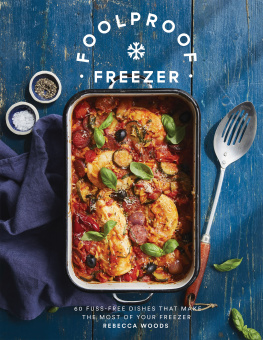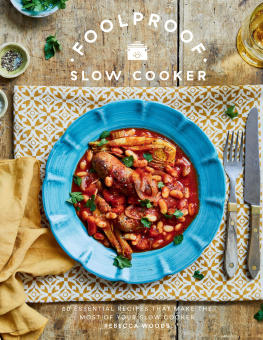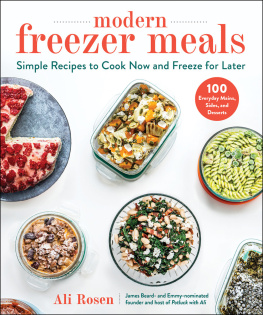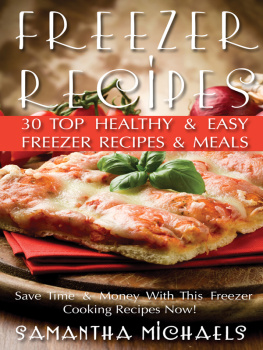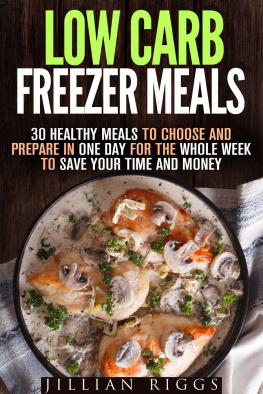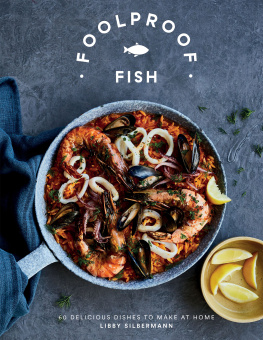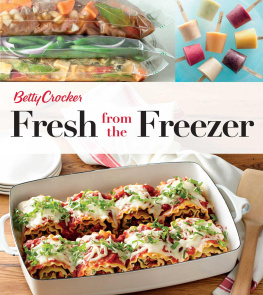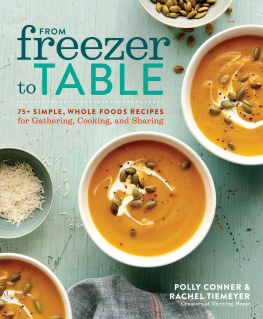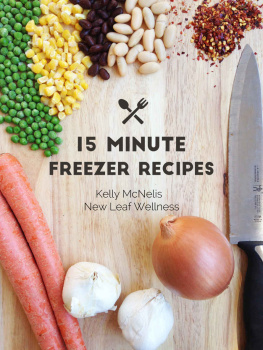
The chapters in this book are arranged according to my five basic freezer categories:
Meat
Theres a huge array of meats available in the frozen aisle in supermarkets, and I have tried to use those for the recipes in this book. But theres no need to stick to these. Most meats freeze really well, and some are even improved by freezing theres much written about the tenderizing action of freezing on beef steak. Also, many fresh meats are better quality than those you might buy frozen, so you can choose according to how flush you feel at the time. If going fresh, my advice would be to grab what you can while its on offer and freeze for when the urge to cook takes you. But when cooking with any large cut of meat, make sure you leave enough time for it to defrost naturally before you start cooking. Here are some of my favourite staples:
Smoked bacon lardons are a brilliant freezer staple. They are small, so can be cooked from frozen, and a handful of these can add instant flavour to soups, stews and pasta sauces.
Ham end chunks can often be bought from your butcher or in tubs from the deli counter at the supermarket. These are great for chucking into dishes (such as my ) to bulk them up and add protein without too much planning.
Mince is the classic frozen meat, so many of the recipes in this book use varying types of it lamb, beef, pork, etc. Its economic, quick and easy to use, and once you have cooked it into a dish, it tends to re-freeze well too.
Fish
You can find a massive range of fish in the freezer section, and some of it is fresher and more nutritious than that on the fishmongers counter as it has been frozen at sea, almost immediately after being caught. This freshness is especially important for dishes such as my , where the fish is cooked only in the acid from the citrus fruit. However, many frozen fish products come in highly processed formats when something has been crumbed or battered by the manufacturer, suspicious ingredients tend to sneak in. (And if you have a bag of fresh crumbs in your freezer see opposite this is an easy step to do yourself.) Instead, focus on economical plain fish fillets that can be cooked in a huge variety of ways, or the seafood that is often prohibitively expensive to buy fresh, but which you can get great deals on if purchased frozen think huge prawns, scallops, squid and tuna steaks. If you have an international supermarket near you, the selection is often even broader and you can find all sorts of fish not necessarily found in UK supermarkets, as well as shellfish and baby octopus. Or, of course, buy whatever is on offer fresh and freeze for another day.
Carbs
Pastry can be the base for so many meals or treats pies, empanadas, fruit tarts, etc. Its easy to combine with many things that youll find in the freezer, so if youre well stocked, youll be able to make something, even if the cupboards and fridge are bare.
Bread is also one of the things I use my freezer for a lot. Bread is not pleasant once it starts to go stale, and so every fresh loaf is sliced and placed in a freezer bag, ready to pull out a slice whenever I fancy a piece of toast. And once defrosted, its as fresh as the day it was frozen. If it is a little past it, see my recipe.
If you have bread thats starting to go a little stale, breadcrumbs are a brilliant thing to have stashed in the freezer. They can add a crunch to the top of so many dishes.
Potatoes in various formats seem to take up an enormous amount of space in freezer aisles these days. Arguably, they shouldnt form part of a daily diet, but for a weekend treat, they are a handy way to add a dish to the table with minimal fuss. And there are many ways to make them a little less beige see my recipes for .
Vegetables
Where once the frozen veg selection was limited to basics such as peas and sweetcorn kernels, now you can even buy bags of avocado, pomegranate seeds or different mixes for smoothies or stir fries. Im not going to dwell on these mixes in this book, as no one really needs a recipe for a stir fry or a smoothie. Instead, my recipes try to use just one or several items that you can keep in your freezer and that can be made with other simple ingredients you will likely already have at home.
Freezing veggies is one of the best ways to preserve their nutrients. Anything that is picked and frozen within hours is far more likely to be fresher and more vitamin packed than that wilting veg that has been lurking in the salad box for a fortnight. However, I do need to add a note of caution when cooking with frozen veg: you do have to be quite careful about what you can use it for. Carrots that have been frozen and defrosted will never be crisp enough to add to a lovely Asian-style salad with satisfying results. They will be more mushy as the freezing process starts to break down their cells. However, for cooking with, when you will be heating them and breaking down the cells in that way anyway, they are often as good as fresh. Likewise, greens which have been frozen only need minimal cooking upon defrosting you certainly dont need to cook them for as long as the same unfrozen variety.
Fruit
Frozen fruit does not share this problem with veg; fruit that has been defrosted and turned a little mushy is not unappealing, making it a star player in your freezer. Chuck a handful of berries, cherries or chunks of tropical fruit into porridge, ice cream, or even into bakes, throw on top of cheesecake or meringue, or blend into a or smoothie.
Other
There are a few supporting stars that I keep in the freezer, which can add flavour in an instant.
Hardy herbs like thyme and rosemary are a saviour. They freeze well and will hang around in your freezer for indefinite periods of time. Plus, they are so aggressive, any friends that grow them will be desperate to get rid of a few branches that you can stash away.
Soft herbs are available to buy frozen, chopped and in bags or boxes. But you can do this yourself too, if you have an ice cube tray. Simply chop the herbs up and fill the holes of the tray about three-quarters full. Top them up with water and freeze. Once frozen, you can pop the cubes out of the tray and put them in a bag, labelled with what herb they are. This method is great for preserving herbs when you have a large bunch that you dont need to use right away, but it does slightly limit their use. Frozen herb cubes are great for popping into a sauce, stew or soup, but because they do break down, sometimes there is no substitute for fresh, so you will find mentions of fresh herbs in this book, too.
Miso paste can be frozen in small single-serving pots, ready to pop into delicious broths for an intensely savoury umami hit.
Wine left in the bottle at the end of an evening can be put to good use in cooking. Simply use it to top up the holes of an ice cube tray and freeze, then, once frozen, transfer to a bag. With this, it doesnt really matter if you mix and match your wines (but keep white and red wines separate) just make wine cubes from any dregs and add to the collection in the freezer. They are great for chucking into sauces or risottos, for example, to save you opening a bottle.
Pesto freezes brilliantly, the oil preserving the delicate basil. Make a batch (see opposite) or buy a good quality fresh one, and freeze divided up into smaller portions.
Harissa can be used to add flavour to meats, fish, sauces, dressings, or anything you feel you want to add a little zing to. Its also often sold in rather large cans that can fester at the back of the fridge when forgotten about. Instead, put any leftovers straight in the freezer in tiny freezer boxes, or freeze in ice cube trays.
Next page
